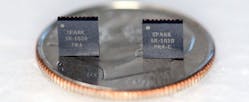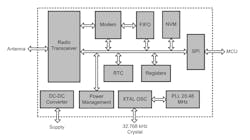Check out more Sensors Converge coverage.
SPARK Microsystems' George Taylor shows off the company's low-power, ultra-wideband (UWB) wireless communication support using a motion-sensing IoT device. The demo is based on the SPARK SR1000 UWB wireless transceivers (Fig. 1). UWB provides low latency and requires little power compared to other wireless communication methodologies.
The SR1010 and SR1020 use frequencies from 3.1 to 6 GHz and 6 to 9.25 GHz, respectively (Fig. 2). They can transmit at speeds up to 10 Mb/s using only 1.5 nJ/bit, and consume a mere 2 mW of power when running a 1 Mb/s. The chips have a 50-MHz SPI interface plus a 1-kb NVM memory.
Latency is 40 µs when running at 1 kb/s. The system also supports time-of-flight (ToF) positioning with a 30-cm accuracy. The chips are supported by an SDK and evaluation kits.

